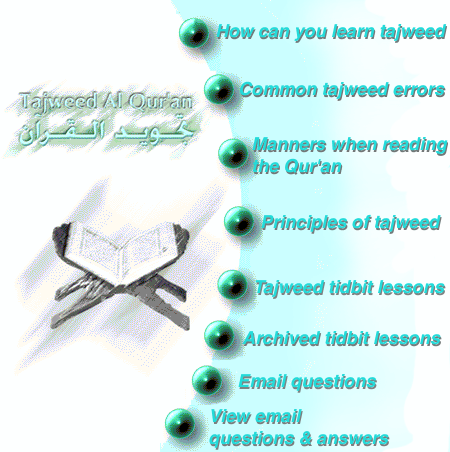|
|

copyright © 2002, abouttajweed.com, all rights reserved |
Question Assalaamu alaikum, Answer Jazakum Allahu khairan.
May Allah may our intention solely for seeking His pleasure, and Aameen to
your dua’. There is one in our
staff who is in the process of getting isnaad in the seven qira’aat by the
simultaneous jama’ method. This
is a lengthy process to say the least. It
generally takes several years to get to the actual reciting of the ijaazah, as
there is over half of the Shatabiyyah to memorize and the explanation has to
be studied with a comprehensive test first. The staff member here at
abouttajweed.com learned the Qur’an and qiraa’aat in Saudi Arabia.
The best way for you to
perfect your recitation is to recite to a sheikh that has an ijaazah of strong
isnaad. There are many such
shuyookh in Egypt, Saudi Arabia, and Syria.
One note, if you have not finished memorizing the Qur’an, you should
finish that before starting on the qira’aat.
As one Sheikh put it, you need to have high school before going on to
University, and just the same, you should memorize the Qur’an and get an
ijaazah in Hafs ‘An ‘Aasim (or Warsh ‘an Naafi’ if you are from the
area of the world where that is prevalent) before undertaking the study of
qira’aat. We were able to find
Qaloon ‘an Naafi’ on the Internet recited by Sheikh Ali Huthayfee, at the
following link: http://www.islamway.com/bindex?section=chapters.php&recitor_id=18
, we were unable to locate the recitation of Dooree Aboo ‘Amrin on the
Internet, and are unaware of its availability in a cassette.
It may exist, we are just unaware of it.
As to the Ikhfa’
question, there is no difference at all in sound or in the method of the
ikhfa’ shafawee and the iqlaab. They
are indeed the same thing in the end. In
the ikhfa’ shafawee, there is a meem saakinah followed by a
The question you have as
to how the ikhfa’ should be done is a question that has been debated much by
the scholars of the Qur’an for the last 20+ years.
Please read the answer to a similar question about the way it is done
at the following link. http://www.abouttajweed.com/23070102.htm This will explain why you are hearing two different “techniques” in the ikhfa’ shafawee by different readers. One thing to note, the
reciter program link on the site does not have the recitation of Sheikh Abu
Bakr Ash-Shatree, it is to the best of our knowledge Sheikh Minshaawee. |